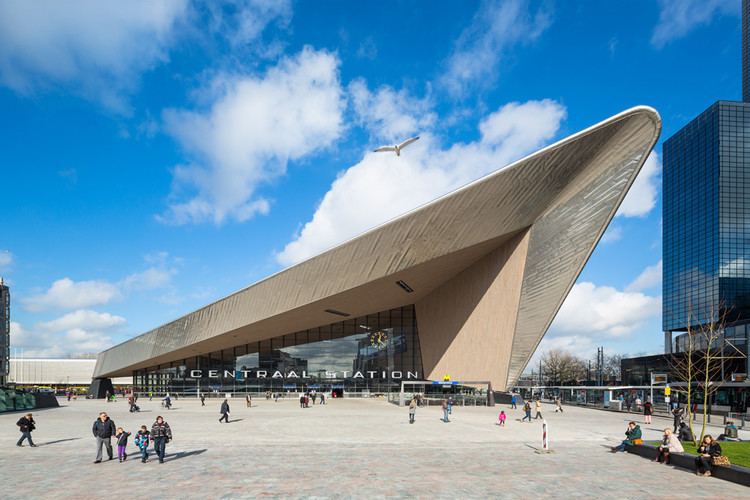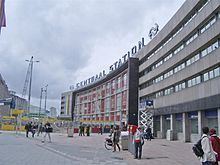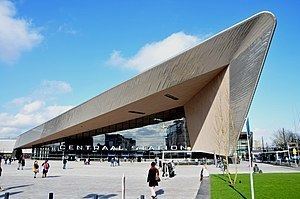Location Netherlands Height 30 m Platforms in use 13 | Station code Rtd Opened 13 March 2014 | |
 | ||
Connections RET Rotterdam Metro: D, E RET Rotterdam Tram: 4, 7, 8, 12, 20, 21, 23, 24, 25 RET: 33, 38, 39, 40, 44, 48 Eurolines Architects Jan Benthem, Adriaan Geuze, Jeroen van Schooten, Marcel Blom Similar Erasmusbrug, Euromast, Amsterdam Centraal station, Den Haag Centraal railway st, Rotterdam Blaak station | ||
Rotterdam Centraal ( [rɔtərˈdɑm sɛnˈtraːl]) is the main railway station of the city Rotterdam in the Netherlands. The station received an average of 110,000 passengers daily in 2007. The current station building, located at Station Square, was officially opened in March 2014.
Contents
- History
- New Rotterdam Centraal
- Destinations
- Train services
- Metro services
- Tram services
- Bus services
- Amenities
- References

History

Before World War II, Rotterdam did not have a central railway station - instead there were four stations in and around the city centre:


Delftse Poort station was badly damaged by bombing in the Rotterdam Blitz. The new Centraal station was rebuilt just westwards of the site. Its original building was designed by architect Sybold van Ravesteyn and was completed on 13 March 1957, officially opening on 21 May. Maas station had closed in 1953 and trains from Utrecht were diverted to Centraal station via the new Rotterdam Noord station. However, the Hofpleinlijn (which later became part of RandstadRail) continued to bypass the station. Hofplein station was eventually closed in 2010 after the Hofpleinlijn was redirected through a tunnel and connected to Centraal station for the first time.

On 9 February 1968 Princess Beatrix opened the first metro line in the Netherlands at Centraal station. The line connected the station to the south of Rotterdam and is now known as Line D. The first subway station had an island platform with two tracks. On 28 September 2009, a new and more spacious underground station opened right next to the old one, which was immediately demolished. The new station has two island platforms with three tracks.

The mainline station nowadays has seven island platforms with thirteen platform tracks. There are three tracks without platform (tracks 2, 5 and 10). In 2007, it was used by approximately 110,000 passengers a day.
The 1957 station building was closed in 2007 and demolished the next year - making it the first major post-war railway station in the Netherlands to be taken down to make way for a new one. The new station was completed and opened in 2014.
New Rotterdam Centraal
A total reconstruction of the station and its surroundings started in 2004 to cope with an increasing number of trains, for example the high-speed train between Amsterdam, Brussels and Paris, and to accommodate for RandstadRail. Furthermore, the existing station, especially the passenger tunnel, also became too small to handle the growing number of passengers. Traveller numbers were projected to be 320,000 per day in 2025. To cope with this increase, a new station was necessary.
In June 2004, ProRail and the Municipality of Rotterdam awarded the a contract to Team CS, a cooperative between Benthem Crouwel Architekten, MVSA Meyer & Van Schooten Architects, and West 8, for transforming the existing plans into a design for the new Central Station.
On 16 May 2006 Mayor Ivo Opstelten revealed a work of Onno Poiesz consisting of the word EXIT, which was mounted behind the windows of the facade. Some of the letters "CENTRAAL STATION" that stood on the roof of the station until its closing were put in a different order by Peter Hopman and Margien Reuvekamp of Bureau Lakenvelder to read "TRAAN LATEN" ("SHED A TEAR"). The final closure of the outdated station took place on September 2, 2007, in the presence of Mayor Opstelten, to allow for the demolition of the station. Between 16 January 2008 and the end of March 2008 the station was completely demolished.
Passengers then, for years, had to use amenities housed in a temporary shelter, a smurf-blue building complex on Conrad Street on the northeast corner of the Groothandelsgebouw. The bicycle tunnel served as a temporary passenger tunnel. On 28 November 2012 the six-times-as-large, new passenger tunnel opened, and on 28 August 2013 the renovated bicycle tunnel opened; the so-called biscuits - artworks that had adorned the wings of the former Central Station - are now above the ends of the bicycle tunnel. The full completion of the station was on 13 March 2014, when the station was reopened by King Willem-Alexander. Rotterdam Centraal Station, as the station is now officially called - on the south side, at the explicit request of the citizens of Rotterdam, the name Centraal Station in the lettering that architect Van Ravensteyn had put on the old station, has returned - will obtain the status of world station, as it is on the international high-speed railway towards Belgium.
In addition to the railway station, the old metro station of Rotterdam Centraal with two tracks and an island platform was renewed and extended to accommodate for the light rail connection to The Hague Central Station. The location of the former island platform is now occupied by switches. The tracks of the RandstadRail Metro Line E were connected to the rest of the metro network with a new tunnel at Rotterdam Central Station. The new metro station has three tracks and two island platforms. Track 1 serves metro line E, part of RandstadRail in the direction Den Haag Central Station. Track 2 is for metro line E towards Slinge; additional services between Slinge - Rotterdam Central vv also use track 2 as terminus of metro line D. Track 3 is between the two island platforms; uniquely the doors of the subway open on both sides while halting at this platform. The latter track is used as the starting point of Metro Line D to the Akkers. On 28 September 2009 the new metro station was opened, after it had been closed for two days. The connection for RandstadRail was officially opened on 16 August 2010, a day after it was available for passenger service.
On 26 March 2014, one of the 60-year-old trees that had to 'move' to allow for the renovation of the station area was placed on Conrad Street.
Destinations
As it is one of the four main stations in the Netherlands it is well connected with cities all over the country. Major destinations include:
Amsterdam, Amersfoort, Bergen op Zoom, Breda, Dordrecht, Delft, Den Haag, Eindhoven, Gouda, Groningen, Haarlem, Hoek van Holland (Ferry to Harwich UK), Leeuwarden, Leiden, Middelburg, Roosendaal, Tilburg, Utrecht, Venlo, Vlissingen and Zwolle.
There are also international services to Antwerpen, Brussels and Paris up to 14 times a day and to Lille twice per day.
Train services
The station is served by the following service(s):
Metro services
Rotterdam Centraal currently serves as a terminus for metro line D, while line E trains continue further south to Slinge station, sharing the section between Rotterdam Centraal and Slinge with line D. The trains are operated by RET
Tram services
The station is served by almost all lines in the Rotterdam tramway network (4, 7, 8, 12, 20, 21, 23, 24 and 25) and are operated by RET
The routes of the trams are as follows:
Bus services
There are also 13 nightbus lines operating every Friday and Saturday.
Amenities
The new travelers passage includes two supermarkets, a HEMA, a Burger King, a restaurant, and two branches of Starbucks. There is also a "Station Living room". The south side features an underground bicycle parking for over 5,000 bicycles. Both the north and the south side have taxi stops. Under the Kruisplein an underground parking garage has been built with a water storage facility on top; This garage is accessible from the south (=west-east) tube of the Weena Tunnel and will be connected to the parking garage under the Schouwburgplein.
